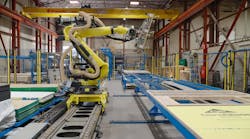The demand for building performance and efficiency is increasing. As a result, projects are becoming more complex, and newer buildings have more automated systems. Office buildings that formerly had three building systems now might have more than 15. A research facility or hospital might have more than 50 systems.
Growth in the number and integration of building systems is driven by several variables, including:
-
Concerns about energy efficiency and sustainability.
-
The desire for increased operational efficiency and flexibility.
-
Occupant comfort and productivity.
-
Safety, security, and surveillance.
-
Electric-utility programs for managing and reducing peak power loads via interactive demand-response systems.
MORE DISCIPLINES
The drive to expand building systems has resulted in the involvement of a wider variety of technical disciplines — such as energy efficiency, energy management, lighting control, daylighting, active facade, information technology (IT), and physical and network security — in building design, construction, and operation.
Additional disciplines and objectives require changes to our business processes. The move to an integrated multidisciplinary design process — and the stress this places on traditional specifications — has received the most attention. (For more information on this topic, see “Specifying High-Performance Buildings and Systems” in the November 2006 issue of HPAC Engineering.)
Design is the beginning — not the end — of the need for mutual understanding and cooperation among disciplines. Ongoing cooperation is required during construction and commissioning. One of our biggest challenges is to maintain buildings so that they keep their high-performance status over time, despite maintenance, tenant improvements, remodeling, system upgrades, and personnel changes.
MORE SENSORS AND SYSTEMS
Automating buildings to support the variables previously outlined requires additional sensors and systems. New applications, such as daylighting, also require additional sensors and systems. Additional sensors allow systems to monitor and control with much more detail.
Sensor and system types will vary based on the building and expected usage. They might include:
-
Energy metering and energy-management controls for individual spaces, tenants, or devices.
-
Indoor-air-quality measurement in small zones or individual spaces.
-
Lighting control at the individual fixture level, daylight sensors, or automated controls for window shades or blinds.
-
Occupancy sensors used for lighting, HVAC, security, and other applications.
This system proliferation can result in a technology convergence as well as a confluence of confusing terminology.
TECHNOLOGY AND TERMINOLOGY
The good news is that the technology for different building systems is converging and standards facilitate interoperability and integration among systems. For example, data from occupancy sensors can be shared with lighting-control, HVAC, and security applications.
Standards also make it possible to minimize the number and types of cables required for connecting devices.
The bad news is that every technical discipline and system comes with its own vocabulary of specialized terms and acronyms. These terms are added to the mix and may appear in conversation or project documents.
This becomes confusing when a term or acronym is used by more than one group, and each usage has a different meaning. Contradictory definitions develop naturally in isolated subgroups but must be reconciled for mutual understanding.
A SOLUTION
How do we solve this problem? Various industry groups, such as the Continental Automated Buildings Association (www.caba.org), are working on intelligent-building issues.
The Building Intelligence Group recently published “Intelligent Building Dictionary: Terminology for Smart, Integrated, Green Building Design, Construction, and Management.” Available for free at www.intelligent-building-dictionary.com or for purchase in book form (see sidebar), the dictionary has definitions of more that 2,500 terms related to building systems, information technology, wireless systems, green building, etc. It also includes tables of reference information and diagrams for cabling standards.
The Web site is designed for quick reference. Users can contribute by suggesting new terms and definitions or by providing feedback. User contributions help other users keep up with new technology and terms.
To maintain the quality and usefulness of the dictionary, all contributions are reviewed by an editor before they appear online. This allows the Building Intelligence Group to maintain the quality of the information.
Chuck Ehrlich is the chief technology officer of Building Intelligence Group LLC and editor of “Intelligent Building Dictionary.” He received a bachelor's degree in engineering and a master's degree in computing and information sciences from Case Western Reserve University and a master's of business administration from the University of San Francisco.
Smart Lexicon
The Building Intelligence Group's online “Intelligent Building Dictionary” is available in book form. The price is $39.95 for hardcover and $29.95 for paperback. To order, go to www.handsonguide.com/pubs.php.








